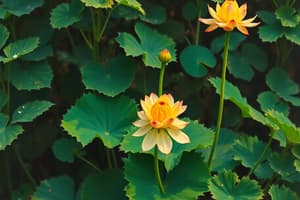Podcast
Questions and Answers
Which of the following is a branch of biology that deals specifically with the study of plants?
Which of the following is a branch of biology that deals specifically with the study of plants?
- Botany (correct)
- Microbiology
- Physiology
- Zoology
What is the primary difference between living and non-living things?
What is the primary difference between living and non-living things?
- Living things consume food, while non-living things do not.
- Living things can move, while non-living things cannot.
- Living things carry out life processes, while non-living things do not. (correct)
- Living things have a defined shape, while non-living things do not.
- Living things are made of organic matter, while non-living things are not.
Which of the following is an example of inorganic matter?
Which of the following is an example of inorganic matter?
- Rocks (correct)
- Petroleum
- Wood
- Feces
What is the name of the exam component that involves practical activities and experiments?
What is the name of the exam component that involves practical activities and experiments?
What does the abbreviation PSBAT stand for in the context of the objectives mentioned in Unit 1.1?
What does the abbreviation PSBAT stand for in the context of the objectives mentioned in Unit 1.1?
Which of the following is a common characteristic shared between humans and plants?
Which of the following is a common characteristic shared between humans and plants?
Which of the following is NOT a branch of biology mentioned in the text?
Which of the following is NOT a branch of biology mentioned in the text?
Based on the provided content, what is the primary focus of Unit 1.1?
Based on the provided content, what is the primary focus of Unit 1.1?
Which type of teeth is primarily used for cutting and biting food?
Which type of teeth is primarily used for cutting and biting food?
What is the primary function of canines in mammals?
What is the primary function of canines in mammals?
What nutritional deficiency disease is associated with a lack of vitamin C?
What nutritional deficiency disease is associated with a lack of vitamin C?
Which of the following nutrients is NOT part of a balanced diet?
Which of the following nutrients is NOT part of a balanced diet?
How is the dental formula of herbivores characterized?
How is the dental formula of herbivores characterized?
What is dentition primarily concerned with?
What is dentition primarily concerned with?
Which deficiency disease is a person likely to suffer from due to a lack of calcium?
Which deficiency disease is a person likely to suffer from due to a lack of calcium?
What types of teeth are primarily designed for grinding food?
What types of teeth are primarily designed for grinding food?
What is the primary function of nerve tissue?
What is the primary function of nerve tissue?
How is xylem tissue specialized for its function?
How is xylem tissue specialized for its function?
What role does adipose tissue play in the body?
What role does adipose tissue play in the body?
Which tissue in plants is primarily involved in the transport of manufactured food?
Which tissue in plants is primarily involved in the transport of manufactured food?
Which of the following organs is primarily involved in digestion?
Which of the following organs is primarily involved in digestion?
What constitutes a system in biological terms?
What constitutes a system in biological terms?
Which tissue is NOT mentioned as one of the main tissues in plants?
Which tissue is NOT mentioned as one of the main tissues in plants?
Which organ in plants is responsible for photosynthesis?
Which organ in plants is responsible for photosynthesis?
What is the primary function of amylase in saliva?
What is the primary function of amylase in saliva?
What happens to amylase when it is boiled?
What happens to amylase when it is boiled?
Which substance in saliva is identified as a protein?
Which substance in saliva is identified as a protein?
In the experiment investigating the effects of temperature on enzymes, what was the temperature of the water bath used?
In the experiment investigating the effects of temperature on enzymes, what was the temperature of the water bath used?
What is the main observation expected when testing for starch after adding amylase at room temperature?
What is the main observation expected when testing for starch after adding amylase at room temperature?
Which reagent is used for testing proteins in saliva?
Which reagent is used for testing proteins in saliva?
What was used to stimulate the release of saliva in the enzyme investigation?
What was used to stimulate the release of saliva in the enzyme investigation?
Why should the experiment involving saliva be performed alone?
Why should the experiment involving saliva be performed alone?
Which of the following is NOT a function of water in the human body?
Which of the following is NOT a function of water in the human body?
A deficiency in which mineral leads to the development of rickets, especially in infants?
A deficiency in which mineral leads to the development of rickets, especially in infants?
What is the primary function of roughage in the human digestive system?
What is the primary function of roughage in the human digestive system?
Which of the following food sources is NOT a good source of iron?
Which of the following food sources is NOT a good source of iron?
What is the primary function of iodine in the human body?
What is the primary function of iodine in the human body?
A deficiency in nitrogen can lead to problems with the development of which of the following?
A deficiency in nitrogen can lead to problems with the development of which of the following?
What color indicates the presence of starch when conducting an iodine test?
What color indicates the presence of starch when conducting an iodine test?
Which of the following is NOT a good source of calcium?
Which of the following is NOT a good source of calcium?
Which of these animals belongs to the phylum Annelida?
Which of these animals belongs to the phylum Annelida?
Which of these organisms belong to the kingdom Protista?
Which of these organisms belong to the kingdom Protista?
Which of these organisms are described as eukaryotic heterotrophs?
Which of these organisms are described as eukaryotic heterotrophs?
Which phylum contains organisms with a hard exoskeleton and jointed limbs?
Which phylum contains organisms with a hard exoskeleton and jointed limbs?
What distinguishes organisms in the kingdom Monera from the kingdom Protista?
What distinguishes organisms in the kingdom Monera from the kingdom Protista?
Which of the following characteristics is shared by all living organisms in the kingdoms Plantae, Fungi, and Protista?
Which of the following characteristics is shared by all living organisms in the kingdoms Plantae, Fungi, and Protista?
Which phylum includes animals with a soft body, a hard shell, and are not segmented?
Which phylum includes animals with a soft body, a hard shell, and are not segmented?
Which kingdom contains organisms that are generally saprophytes or parasites and have cell walls made of chitin?
Which kingdom contains organisms that are generally saprophytes or parasites and have cell walls made of chitin?
Flashcards
Biology
Biology
The study of living things and their characteristics.
Branches of Biology
Branches of Biology
Different specialized fields within biology, such as Botany and Zoology.
Living Organisms
Living Organisms
Entities that exhibit life processes, such as growth and reproduction.
Non-living Things
Non-living Things
Signup and view all the flashcards
Matter
Matter
Signup and view all the flashcards
Organic Matter
Organic Matter
Signup and view all the flashcards
Inorganic Matter
Inorganic Matter
Signup and view all the flashcards
Characteristics of Living Things
Characteristics of Living Things
Signup and view all the flashcards
Amylase
Amylase
Signup and view all the flashcards
Starch
Starch
Signup and view all the flashcards
Maltose
Maltose
Signup and view all the flashcards
Denaturation
Denaturation
Signup and view all the flashcards
Biuret Test
Biuret Test
Signup and view all the flashcards
Effect of temperature on enzymes
Effect of temperature on enzymes
Signup and view all the flashcards
Saliva
Saliva
Signup and view all the flashcards
Iodine Test
Iodine Test
Signup and view all the flashcards
Platyhelminthes
Platyhelminthes
Signup and view all the flashcards
Annelida
Annelida
Signup and view all the flashcards
Nematoda
Nematoda
Signup and view all the flashcards
Mollusca
Mollusca
Signup and view all the flashcards
Arthropoda
Arthropoda
Signup and view all the flashcards
Chordata
Chordata
Signup and view all the flashcards
Fungi Kingdom
Fungi Kingdom
Signup and view all the flashcards
Monera
Monera
Signup and view all the flashcards
Nerve Tissue
Nerve Tissue
Signup and view all the flashcards
Adipose Tissue
Adipose Tissue
Signup and view all the flashcards
Palisade Tissue
Palisade Tissue
Signup and view all the flashcards
Xylem Tissue
Xylem Tissue
Signup and view all the flashcards
Phloem Tissue
Phloem Tissue
Signup and view all the flashcards
Organ
Organ
Signup and view all the flashcards
System
System
Signup and view all the flashcards
Organism
Organism
Signup and view all the flashcards
Calcium (Ca)
Calcium (Ca)
Signup and view all the flashcards
Iron (Fe)
Iron (Fe)
Signup and view all the flashcards
Iodine (I)
Iodine (I)
Signup and view all the flashcards
Nitrogen (N)
Nitrogen (N)
Signup and view all the flashcards
Roughage (fibre)
Roughage (fibre)
Signup and view all the flashcards
Food Tests
Food Tests
Signup and view all the flashcards
Iodine test for starch
Iodine test for starch
Signup and view all the flashcards
Balanced Diet
Balanced Diet
Signup and view all the flashcards
Seven Food Nutrients
Seven Food Nutrients
Signup and view all the flashcards
Nutritional Deficiency Diseases
Nutritional Deficiency Diseases
Signup and view all the flashcards
Calcium Deficiency Disease
Calcium Deficiency Disease
Signup and view all the flashcards
Vitamin A Deficiency Disease
Vitamin A Deficiency Disease
Signup and view all the flashcards
Protein Deficiency Disease
Protein Deficiency Disease
Signup and view all the flashcards
Types of Teeth
Types of Teeth
Signup and view all the flashcards
Dentition
Dentition
Signup and view all the flashcards
Study Notes
Introduction to Biology for Grade Ten
- Biology is a branch of science that studies living things.
- In grade nine, students studied environmental science, which is now divided into three subjects: Biology, Chemistry, and Physics.
- Biology includes sub-disciplines like Botany (plants), Zoology (animals), Physiology (functions), Genetics, Biochemistry, Microbiology, Geology, Virology, and more.
- The course will explore various interesting aspects of animals and plants.
- The final assessment will comprise three papers: two theory papers (I & II) and one practical paper (III).
Unit 1.1: Living and Non-Living Things
- Living things (e.g., animals, plants) are differentiated from non-living things (e.g., rocks, metals) by their characteristics.
- Living and non-living things are both made of matter that occupies space and has mass.
- Key characteristics of living things include:
- Reproduction
- Movement
- Growth
- Feeding
- Respiration
- Excretion
- Sensitivity (irritability or reacting to stimuli)
Unit 1.1: Processes in Living Organisms
- Reproduction: The process of producing offspring.
- Different organisms use sexual or asexual reproduction.
- Movement: Many organisms move from one place to another, while plants grow.
- Growth: An increase in size and/or number of cells.
- Feeding: Organisms obtain materials and energy from their environment.
- Respiration: The process of releasing energy from food.
- Excretion: Removal of waste products from the body.
- Sensitivity (Irritability): The ability to detect and respond to changes in the environment.
Unit 1.2: Cells
- Cells are the basic functional units of life in all living organisms
- Microscopes (such as hand lenses and compound microscopes) are used to observe cells.
- Different types of microscopes have different magnifying powers.
- Cells contain components (organelles) that perform specific functions. These organelles include the nucleus, cytoplasm, cell membrane, mitochondria, ribosomes, endoplasmic reticulum, and golgi bodies.
Unit 1.2: Common Cell Structures
- Cell Membrane: Controls what enters and leaves the cell. Selectively permeable.
- Cytoplasm: The jelly-like substance inside the cell that contains organelles. Active site for metabolic reactions.
- Nucleus: Controls the activities of the cell. Contains DNA.
- Mitochondria: Sites of cellular respiration, where energy is released from food.
- Ribosomes: Sites of protein synthesis.
- Endoplasmic reticulum: A network of channels that transports materials within the cell.
- Golgi bodies: Modifies and packages proteins and other materials for transport.
- Cell Wall: (Plant cells only) Provides support and protection to the cell. Rigid structure.
- Vacuoles: Storage organelles, especially for water. (More prominent in plant cells)
- Chloroplasts: (Plant cells only) Contain chlorophyll for photosynthesis.
Unit 1.2: Cell Specialisation
- Cells in multicellular organisms are specialized for particular functions.
- Different cell types like blood cells, nerve cells, muscle cells, etc, have unique structures to perform their specific functions.
Unit 1.3: Cell Organisation
- Tissues are groups of similar cells performing a specific function.
- Organs are structures formed by the combination of different tissues working together to perform a particular function.
- Systems are groups of organs working together to carry out a wide range of functions.
- Examples of tissues and organs.
- Muscle Tissue
- Nerve tissue
- Adipose tissue
- Pallisade tissue
- Xylem tissue
- Phloem tissue
- The order of complexity : Cell < Tissue < Organ < Organ System < Organism
Unit 1.4: Diffusion and Osmosis
- Diffusion: The movement of particles from an area of higher concentration to an area of lower concentration.
- Osmosis is the specific type of diffusion where only water molecules move from an area of higher water concentration to an area of lower water concentration across a semipermeable membrane.
- Factors influencing the rate of diffusion include:
- Temperature
- Surface area
- Concentration gradient
- Thickness of the membrane
- Osmosis influences the shape and functioning of plant and animal cells in solutions that have different concentrations of water.
Unit 1.5: Enzymes
- Enzymes: Biological catalysts; increase the rate of metabolic reactions; are proteins; are specific to a particular reaction; work best at an optimum temperature and pH.
- Factors affecting enzyme activity
- Temperature
- pH
- Substrate Concentration and/or substrate availability
Unit 1.6: Classification
- Classification: The organisation of living things into groups and subgroups based on their similarities and differences in structure and function. Uses a hierarchy of groups.
- Kingdom: The largest grouping of organisms.
- Phylum: A grouping within a kingdom.
- Class: A grouping within a phylum.
- Order: A grouping within a class.
- Family: A grouping within an order.
- Genus: A grouping within a family.
- Species: The smallest grouping of organisms.
- Naming of organisms: Uses the binomial (two-name) system of nomenclature (e.g., Homo sapiens).
Unit 2.1: Classification of Nutrients
- Nutrients: Substances in food needed for the body's growth, development, and energy production
- Types of nutrients
- Carbohydrates
- Proteins
- Fats
- Vitamins
- Minerals
- Water and roughage
Unit 2.2: Dentition
- Dentition: The study of teeth in mammals; their types (incisors, canines, premolars, and molars); and their arrangement in the jaw.
- Each kind of teeth performs a particular function. Different types of teeth perform different functions.
- Dental formulae illustrate the number of each different kind of teeth in a mammal (used for classification)
Unit 2.3: Animal Nutrition
- Holozoic Nutrition: The method of taking in complex organic molecules by animals.
- The process of holozoic nutrition includes: ingestion, digestion absorption, and egestion.
- The digestive system is a tube that begins at the mouth and ends at the anus.
- Parts of the digestive system: mouth, esophagus, stomach, small intestine, large intestine, anus.
Unit 2.4: Plant Nutrition
- Photosynthesis: The process of plant food manufacture; a complex two-part process involving light-dependent reactions and the subsequent dark reaction. Requires specific components (chlorophyll, water, minerals).
- Environmental factors affecting photosynthesis include light intensity, carbon dioxide concentration, temperature, water availability.
- Testing for starch in leaves can verify the presence of photosynthesis.
Studying That Suits You
Use AI to generate personalized quizzes and flashcards to suit your learning preferences.




